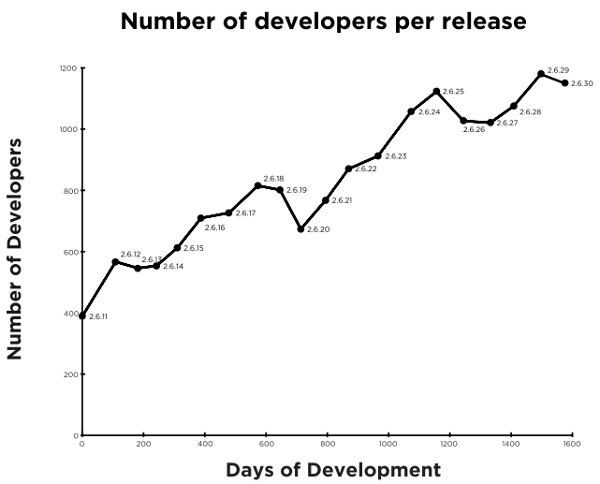
Hot on the heels of the news of UNIX’s 40th anniversary comes a Linux Foundation report entitled Who Writes Linux. This report investigates who is contributing to the Linux kernel, and how much: “Since 2005, over 5000 individual developers from nearly 500 different companies have contributed to the kernel. The Linux kernel, thus, has become a common resource developed on a massive scale by companies which are fierce competitors in other areas.” Wow!
It bears noting that an analysis like this is only available because Linux is open source software. You can look through the changelogs and project history to see who has done what, who’s been attributed with doing what, etc etc.
ComputerWorld has done a nice job of summarizing the top contributing corporations. Lumped in with the expected participants (Red Hat, IBM, Novell) are some less likely companies (SGI, Parallels, Renesas Technology):
- Red Hat: 12.3%
- IBM: 7.6%
- Novell: 7.6%
- Intel: 5.3%
- Independent consultant: 2.5%
- Oracle: 2.4%
- Linux Foundation: 1.6%
- SGI 1.6%
- Parallels 1.3%
- Renesas Technology: 1.3%
- Academia: 1.2%
- Fujitsu: 1.1%
- MontaVista: 1.1%
- MIPS Technologies: 1.1%
- Analog Devices: 1.0%
- HP: 1.0%
As Vaughan-Nichols notes:
You see, Linux isn’t just some hobby, nor is it just being used by some businesses that specialize in it. No, Linux is made by big business for big business, and it has been for some time.
Businesses can use Linux because it’s such a robust, viable operating system: it frees them from having to develop and maintain their own operating systems for specialized (usually embedded) systems, and instead focus on applications develop for those systems. A lot people like to pooh-pooh Linux because they may have had some trouble using it on their crazy home-brew desktop system, but it’s clear that Linux is a very successful part of the computer industry today.
The Linux Foundation report itself is chock full of easy-to-read tables with interesting data (changes per hour, lines modified per day, etc). If you’re curious about Linux development, this is a pretty good glimpse at it. From a purely academic perspective, it would be fun to compare this data with similar data from Apple and Microsoft regarding OSX and Windows development, respectively. Good luck getting that data from them, though.